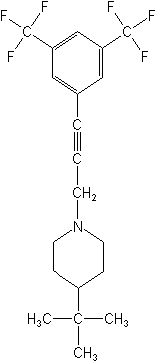|
Activity:
Rodenticide
(unclassified)
CAS Name:
1-[3-[3,5-bis(trifluoromethyl)phenyl]-2-propynyl]-4-(1,1-dimethylethyl)piperidine
Structure:

Regulatory
Information
(only comprehensive for the US) |
| US
EPA Registered: |
No |
| Other
Information |
| Molecular
Formula: |
C20H23
F6 N |
| Manufacturers: |
Aventis |
| Other
Names: |
M&B
36892 |
|
Health
Effects:
As of
Nov 2002: no data available |
|
Environmental
Effects
As of
Nov 2002: no data available |
Note:
the only information we could find on this rodenticide are the following
2 abstracts (as of Nov 23, 2002):
http://www.ncbi.nlm.nih.gov:80/entrez/query.fcgi?cmd=Retrieve&db=PubMed&list_uids=4067302&dopt=Abstract
J Hyg (Lond)
1985 Oct;95(2):513-8
Pen
and field trials of flupropadine against the house mouse (Mus musculus
L.).
Rowe FP, Bradfield A, Swinney T.
Laboratory and field trials were conducted to determine the efficacy
of the candidate rodenticide flupropadine against the house mouse
(Mus musculus L.). In laboratory feeding tests, family groups of
wild mice maintained in pens and conditioned to feeding on plain
foods were offered flupropadine at either 0.10%, 0.15%, 0.18% or
0.20% in pinhead oatmeal bait. Overall mortalities in replicated
21-day treatments were 66/71 (93.0%), 71/79 (89.9%), 72/76 (94.7%)
and 69/75 (92.0%) respectively. In 17 field trials carried out against
mice infesting farm buildings, flupropadine was used at 0.10%, 0.15%
and 0.18% in oatmeal bait. Mean treatment success, estimated from
live-capture and mortality data, was 88.6%, 96.2% and 96.6% respectively.
Flupropadine was found to be as near effective against mice as calciferol/warfarin
and the second-generation anticoagulant rodenticides difenacoum,
bromadiolone and brodifacoum. In further comparison with the anticoagulants,
treatment with flupropadine bait achieved markedly quicker control.
http://www.ncbi.nlm.nih.gov:80/entrez/query.fcgi?cmd=Retrieve&db=PubMed&list_uids=3840823&dopt=Abstract
J Hyg (Lond)
1985 Oct;95(2):505-12
Field
trials of a new sub-acute rodenticide flupropadine, against wild
Norway rats (Rattus norvegicus).
Buckle AP.
Fifteen experimental treatments with rodenticidal baits containing
0.1, 0.15 or 0.2% flupropadine were conducted on farmsteads against
Rattus norvegicus infestations. Eight treatments were completely
successful and the others gave kills ranging from 36 to 72% in 28
days. Treatments with 0.1 and 0.15% flupropadine were less successful
against large infestations than against small ones. Flupropadine
was most successful at 0.2% but still gave incomplete kills on farms
where abundant alternative food was available. The compound was
more effective than acute poisons in achieving complete control
of Norway rat infestations, but was less reliable in doing so than
anticoagulants. On the other hand, many flupropadine treatments
gave quicker control and used smaller quantities of bait than anticoagulant
treatments.
|

